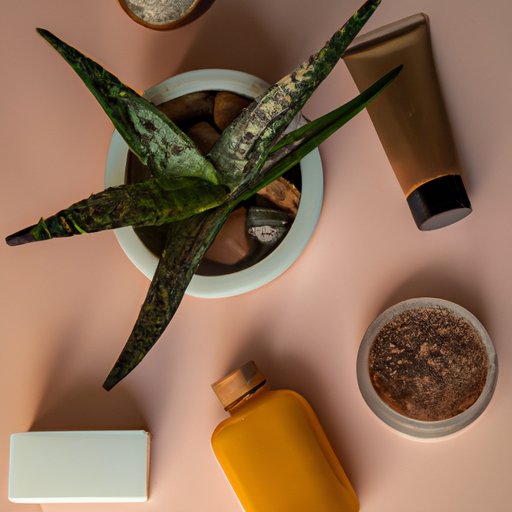Introduction
Acne is a common condition that affects many people around the world. It is characterized by red bumps, whiteheads, blackheads, cysts, or pimples on the face, neck, chest, back, shoulders, and other areas. Chest and back acne can be particularly difficult to treat due to the thicker skin in these areas and the fact that clothing often traps sweat and bacteria against the skin.
There are many causes of chest and back acne, including hormones, genetics, stress, environmental factors, bacterial buildup, improper skin care, and other factors. Fortunately, there are steps you can take to reduce the appearance of chest and back acne and help keep it under control.
Cleanse the Skin Regularly
Cleansing your skin regularly is one of the best ways to prevent chest and back acne. Cleansing removes oils, dirt, and bacteria from the surface of the skin, which can reduce the risk of breakouts. It also helps to keep pores unclogged and can make skin less oily.
When selecting a cleanser, look for one that is designed for acne-prone skin and is gentle enough for sensitive areas. Avoid cleansers with harsh ingredients such as alcohol, fragrances, and synthetic dyes, which can irritate the skin. Use lukewarm water and massage the cleanser into the skin gently for at least 30 seconds before rinsing off.
Use an Exfoliating Scrub
Exfoliating the skin can help remove dead skin cells and unclog pores, which can reduce the risk of breakouts. Look for an exfoliating scrub that contains salicylic acid or glycolic acid, which can help to reduce inflammation and clear away bacteria. Be sure to select a scrub that is gentle enough for sensitive skin.
To use an exfoliating scrub, apply it to damp skin and massage it in circular motions for one to two minutes. Rinse off with lukewarm water and pat the skin dry. Avoid exfoliating more than once or twice a week, as this can lead to irritation.
Apply Topical Acne Treatments
Topical treatments such as creams, gels, and lotions can help to reduce the appearance of chest and back acne. These products contain active ingredients such as benzoyl peroxide, salicylic acid, and retinoids, which can help to reduce inflammation and fight bacteria. They can also help to unclog pores and reduce oil production.
When applying topical treatments, start by washing the area with a gentle cleanser. Then, apply a thin layer of the product and massage it into the skin until it is completely absorbed. Avoid getting the product on your hands, as this can spread bacteria, and avoid touching, squeezing, or picking at blemishes, as this can cause scarring.
Avoid Touching, Squeezing, or Picking at Blemishes
Touching, squeezing, or picking at blemishes can irritate the skin and cause additional breakouts. It can also lead to scarring and other long-term damage. To avoid these activities, try to keep your hands away from your face and chest, and keep your nails trimmed short.
It can also be helpful to distract yourself when you feel the urge to touch, squeeze, or pick at your skin. Try listening to music, reading a book, or engaging in another activity that you enjoy.
Wear Breathable Fabrics
Clothing that is too tight or made of fabrics that don’t allow air to circulate can trap sweat and bacteria against the skin, which can lead to breakouts. To reduce the risk of chest and back acne, look for clothes made of breathable fabrics such as cotton and linen.
These fabrics allow air to circulate, which can help to keep the skin cool and dry. Avoid wearing clothes that are too tight, as this can restrict airflow and trap sweat and bacteria against the skin.
Shower Immediately After Exercise
Sweat, bacteria, and dirt can build up on the skin during exercise, which can increase the risk of chest and back acne. To reduce the risk, shower immediately after exercising. Use a gentle cleanser to remove sweat, dirt, and bacteria, and rinse off thoroughly with lukewarm water.
If you don’t have time to shower right away, use a wipe or cloth to remove sweat and bacteria from the skin. Change out of your workout clothes as soon as possible to reduce the risk of chest and back acne.
Try Natural Remedies
In addition to traditional treatments, there are some natural remedies that may help to reduce the appearance of chest and back acne. These include tea tree oil, aloe vera, honey, apple cider vinegar, and turmeric. Before using any natural remedy, it is important to test it on a small patch of skin to make sure it won’t cause irritation.
It is also important to remember that natural remedies may not work for everyone, and they may not provide immediate results. If your chest and back acne does not improve after trying natural remedies, talk to a doctor about other treatment options.
Conclusion
Chest and back acne can be frustrating, but there are steps you can take to reduce its appearance. Start by cleansing the skin regularly and using an exfoliating scrub. Then, try topical treatments and natural remedies. Finally, avoid touching, squeezing, or picking at blemishes, and wear breathable fabrics to keep the skin cool and dry.
If your chest and back acne does not improve after trying these tips, talk to a doctor or dermatologist. They can recommend treatments that are tailored to your specific needs.


